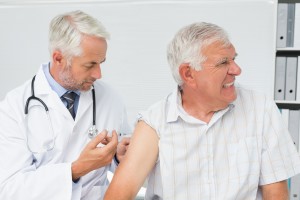Monkeypox1 is a rare disease caused by infection with the monkeypox virus. Monkeypox virus is part of the same family of viruses as variola virus, the virus that causes smallpox. Monkeypox symptoms are similar to smallpox symptoms, but milder, and monkeypox is rarely fatal. Monkeypox is not related to chickenpox. This post “5 “Monkeypox: 20 Things To Know from CDC (7/28/22)” seeks to provide current and relevant information from a trusted source.
Monkeypox was discovered in 1958 when two outbreaks of a pox-like disease occurred in colonies of monkeys kept for research. Despite being named “monkeypox,” the source of the disease remains unknown. However, African rodents and non-human primates (like monkeys) might harbor the virus and infect people.
The first human case of monkeypox was recorded in 1970. Prior to the 2022 outbreak, monkeypox had been reported in people in several central and western African countries. Previously, almost all monkeypox cases in people outside of Africa were linked to international travel to countries where the disease commonly occurs or through imported animals. These cases occurred on multiple continents.
- Two vaccines may be used for the prevention of Monkeypox virus infection:
- JYNNEOS (also known as Imvamune or Imvanex), licensed (or approved) by the U.S. Food and Drug Administration (FDA) for the prevention of Monkeypox virus infection, and
- ACAM2000, licensed (or approved) by FDA for use against smallpox and made available for use against monkeypox under an Expanded Access Investigational New Drug application.
- In the United States, there is currently a limited supply of JYNNEOS, although more is expected in the coming weeks and months.
- There is a larger supply of ACAM2000, but this vaccine should not be used in people who have certain health conditions, such as a weakened immune system, skin conditions like eczema or other exfoliative skin conditions, or pregnancy.
- No data are available yet on the effectiveness of these vaccines in the current outbreak.
- The immune response takes 14 days after the second dose of JYNNEOS and 4 weeks after the ACAM2000 dose for maximal development. People who get vaccinated should continue to take steps to protect themselves from infection by avoid
 ing close, skin-to-skin contact, including intimate contact, with someone who has monkeypox.
ing close, skin-to-skin contact, including intimate contact, with someone who has monkeypox. - To better understand the protective benefits of these vaccines in the current outbreak, CDC will collect data about adverse events and vaccine effectiveness, including whether the vaccine protects a person differently depending on how they were infected with Monkeypox virus.
When properly administered before or after a recent exposure, vaccines can be effective tools at protecting people against monkeypox illness. The following vaccination strategies are being used in the United States:
Monkeypox Vaccine Post-Exposure Prophylaxis (PEP)
- For the current outbreak, this approach can be considered as “standard PEP” for monkeypox. People can be vaccinated following exposure to monkeypox to help prevent illness from monkeypox virus. It is important that states and other jurisdictions identify contacts of confirmed or probable monkeypox cases to offer vaccine for PEP and to monitor for any early signs of illness.
- CDC recommends that the vaccine be given within 4 days from the date of exposure for the best chance to prevent onset of the disease.
- If given between 4 and 14 days after the date of exposure, vaccination may reduce the symptoms of disease, but may not prevent the disease. However, when coupled with self-isolation and other prevention measures when symptoms first occur, PEP is important for controlling outbreaks and preventing further transmission of monkeypox.

Outbreak Response Monkeypox Vaccine Post-Exposure Prophylaxis (PEP)++
- For the current outbreak, this expanded approach can be considered as “individual-directed PEP” for monkeypox; public health officials refer to it as “expanded PEP” or “PEP plus-plus” or “PEP++”.
- People with certain risk factors are more likely to have been recently exposed to monkeypox. The PEP++ approach aims to reach these people for post-exposure prophylaxis, even if they have not had documented exposure to someone with confirmed monkeypox.
- When coupled with self-isolation and other prevention measures when symptoms first occur, PEP++ may help slow the spread of the disease in areas with large numbers of monkeypox cases—which would suggest a higher level of monkeypox virus transmission.
Monkeypox Vaccine Pre-Exposure Prophylaxis (PrEP)
- This approach refers to administering vaccine to someone at high risk for monkeypox (for example, laboratory workers who handle specimens that might contain monkeypox virus).
- At this time, most clinicians in the United States and laboratorians not performing the orthopoxvirus generic test to diagnose orthopoxviruses, including monkeypox virus, are not advised to receive monkeypox vaccine PrEP.
Vaccine Information (JYNNEOS and ACAM2000)
JYNNEOS vaccine is being allocated to jurisdictions for use for the following individuals:
- Known contacts who are identified by public health via case investigation, contact tracing, and risk exposure assessments
- Presumed contacts who may meet the following criteria:
- Know that a sexual partner in the past 14 days was diagnosed with monkeypox
- Had multiple sexual partners in the past 14 days in a jurisdiction with known monkeypox
JYNNEOS doses should be prioritized for those people who are at risk for severe adverse events with ACAM2000 or severe disease from monkeypox (such as people with HIV or other immunocompromising conditions).

- JYNNEOS contains a live virus that does not replicate efficiently in human cells.
- Administered as two subcutaneous injections four weeks apart.
- The immune response takes 2 weeks after the second dose for maximal development.
- Licensed by the FDA for use in the prevention of smallpox or monkeypox in people ages 18 years and older. Use in younger populations requires submission of a single patient Expanded Access Investigational New Drug (IND) application.
- The effectiveness of JYNNEOS against monkeypox is supported by animal studies.
- There are no data on the efficacy of JYNNEOS for PEP or PrEP from the current outbreak. Although this is also true for ACAM2000, there is evidence that the related Dryvax vaccine worked well during the smallpox eradication period. Public health officials have concern about the lack of efficacy data for JYNNEOS, especially because it requires two doses 28 days apart.
- Adverse reactions include injection site reactions such as pain, swelling, and redness.
- People with a severe allergy to any component of the vaccine (gentamicin, ciprofloxacin, egg protein) should not receive this vaccine.
- Safe for administration to people with HIV and atopic dermatitis.
- While there are no data in people who are pregnant or breastfeeding, animal data do not show evidence of reproductive harm; pregnancy and breastfeeding are not contraindications.
*On November 3, 2021, the Advisory Committee on Immunization Practices (ACIP) voted to recommend JYNNEOS pre-exposure prophylaxis as an alternative to ACAM2000 for certain persons at risk for exposure to orthopoxviruses.

- ACAM2000 is a live Vaccinia virus vaccine that is replication competent.
- Administered as one percutaneous dose via multiple puncture technique with a bifurcated needle.
- The immune response takes 4 weeks for maximum development.
- Following a successful inoculation, a lesion (known as a “take”) will develop at the site of the vaccination; the lesion may take up to 6 weeks or more to heal.
- Licensed by the FDA for use against smallpox; allowed for use against monkeypox under an Expanded Access IND, which requires informed consent along with submission of additional forms.
- The effectiveness of ACAM2000 is supported by human clinical trials and animal studies.
- There are no data on the efficacy of ACAM2000 for PEP or PrEP from the current outbreak.
- Adverse reactions include injection site pain, swelling, and redness; fever; rash; lymph node swelling; and complications from inadvertent inoculation.
- People with severe allergy to any component of the vaccine should not receive it. In addition, people with severely weakened immune systems should not receive this vaccine.
- ACAM2000 should not be given to people with the following conditions:
- Cardiac disease
- Eye disease treated with topical steroids
- Congenital or acquired immune deficiency disorders, including those taking immunosuppressive medications and people living with HIV (regardless of immune status)
- Atopic dermatitis/eczema and persons with a history of atopic dermatitis/eczema or other acute or exfoliative skin conditions
- Infants less than 12 months of age
- Pregnancy
Jay Harold hopes you enjoyed this post, “Monkeypox: 20 Things To Know from CDC (7/28/22)” Please share it and read more about Jay Harold here. Please take this advice from Muhammad Ali and give it back to others. “Service to others is the rent you pay for your room here on earth.”
Click this link to get free Health and Wealth information to improve your life. Play the free “Slow Roll Through Civil Rights” Game found on the Jay Harold website. Enjoyed this post? Share it and read more here.




